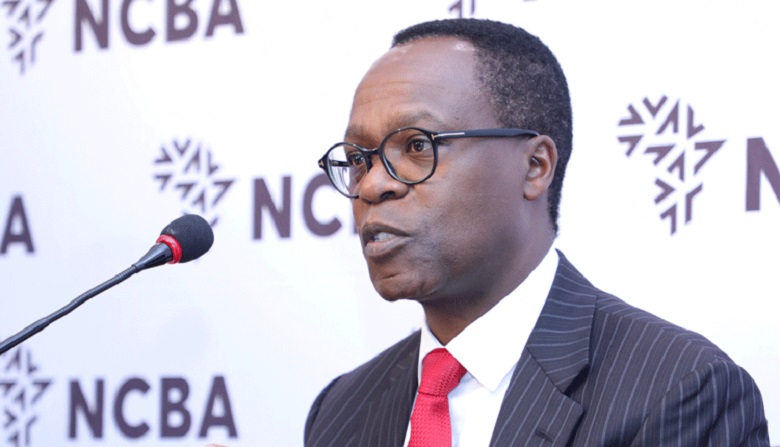NCBA Group PLC has reported a KES 11.1 billion profit after tax for the first half of 2025, marking a 12.6% increase from KES 9.8 billion posted in the same period last year. The strong performance underscores the bank’s strategic focus on digital innovation, operational efficiency, and sustainable financing, positioning NCBA as one of Kenya’s most profitable and progressive lenders.
The results come despite a challenging economic environment, supported by prudent risk management, growing digital lending, and an expanding retail and corporate banking portfolio.
- Profit After Tax: KES 11.1 billion (+12.6% YoY)
- Profit Before Tax: KES 13.6 billion (+11.4% YoY)
- Operating Income: KES 35.3 billion (+12.7% YoY)
- Operating Expenses: KES 18.6 billion (+12.5% YoY)
- Provision for Credit Losses: KES 3.2 billion (+19.1% YoY)
- Digital Loan Disbursements: KES 646 billion (+35% YoY)
- Customer Deposits: KES 497 billion (–6.0% YoY)
- Total Assets: KES 663 billion (–3.8% YoY)
- Interim Dividend: KES 2.50 per share
Group Managing Director John Gachora said the results reflect NCBA’s resilience and innovation-first strategy despite market headwinds.
“Our H1 2025 financial results highlight a rebound and positive business momentum. Income growth of 13% was driven by operational excellence and prudent pricing management, despite a challenging economic environment,” said Gachora.
“We have maintained high-quality assets, with the NPL ratio at 11.9% and cost of risk at 1.4%. Our capital adequacy ratio of 22.4% remains well above regulatory requirements, enabling us to support lending growth and strategic investments.”
Additionally, NCBA has reduced its Base Lending Rate (NBLR) by 4.02% since August 2024, aligning with the Central Bank of Kenya’s monetary easing.
NCBA Bank Kenya contributed 81% of Group profits, delivering a KES 11 billion PBT (profit before tax), up 7.4% YoY, fueled by:
- Improved net interest income, which grew 32% YoY
- Lower cost of funding through optimized treasury operations
- Strong customer acquisition and SME banking activations
The regional subsidiaries contributed KES 1.8 billion PBT, accounting for 13.6% of Group profitability, while non-banking subsidiaries delivered KES 804 million PBT, a 40% YoY growth.
Digital remains central to NCBA’s growth strategy, with KES 646 billion in digital loans disbursed during H1 2025, representing a 35% increase year-on-year. Key innovations include:
- CarDuka Platform Upgrade
Enhanced with AI-powered tools for insurance integration, improved UX, and seamless financing options. - ConnectPlus Corporate Banking
Adopted by 90% of active corporate clients, enabling faster payments, advanced reporting, cash liquidity management, and integrations with financial services platforms. - Digital Onboarding
NCBA Investment Bank surpassed 50,000 clients through digital registration, helping assets under management grow to KES 86 billion.
Through its “Change The Story” sustainability agenda, NCBA made significant environmental and social progress:
- KES 9.5 billion mobilized in green and sustainable financing
- 396,459 trees planted with partners across Kenya
- 55,335 women and youth empowered through mentorship and skills training
- 8,420 participants engaged in national sports partnerships
- KES 90 million invested in community initiatives and golf sponsorships
- 743,768 livelihoods positively impacted through outreach programs
This positions NCBA as a regional leader in ESG-focused banking.
In H1 2025, NCBA earned several prestigious accolades, including:
- Exceptional Customer Experience Award – Kenya Bankers Association
- Excellence in Asset Finance – International Center for Strategic Alliance
- Best Overall Banking Experience – Banking on Women Awards
- Ranked 6th Most Valuable Brand in Kenya – Brand Finance
Looking ahead, Gachora remains optimistic, citing positive macroeconomic indicators:
- GDP growth outlook: 3.0%
- KES/USD exchange rate stability: ~KES 129
- Inflation: 4.1%, within CBK’s target range
- CBR cut to 9.5%, boosting private-sector credit uptake
“NCBA remains committed to sustainable growth by investing in people, technology, and customer experience while driving innovation to meet evolving financial needs,” Gachora said.





